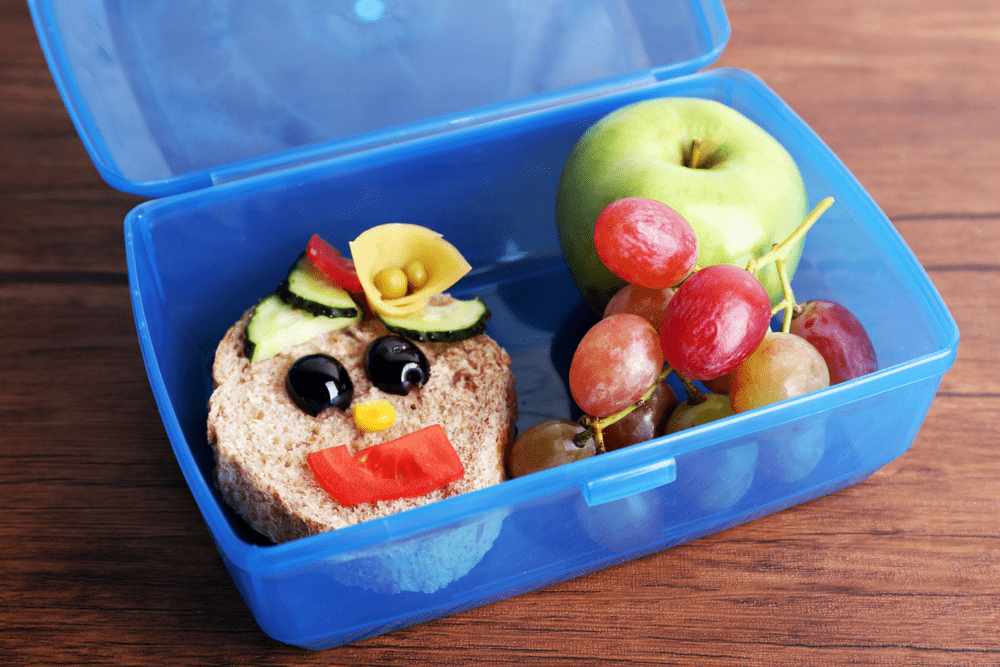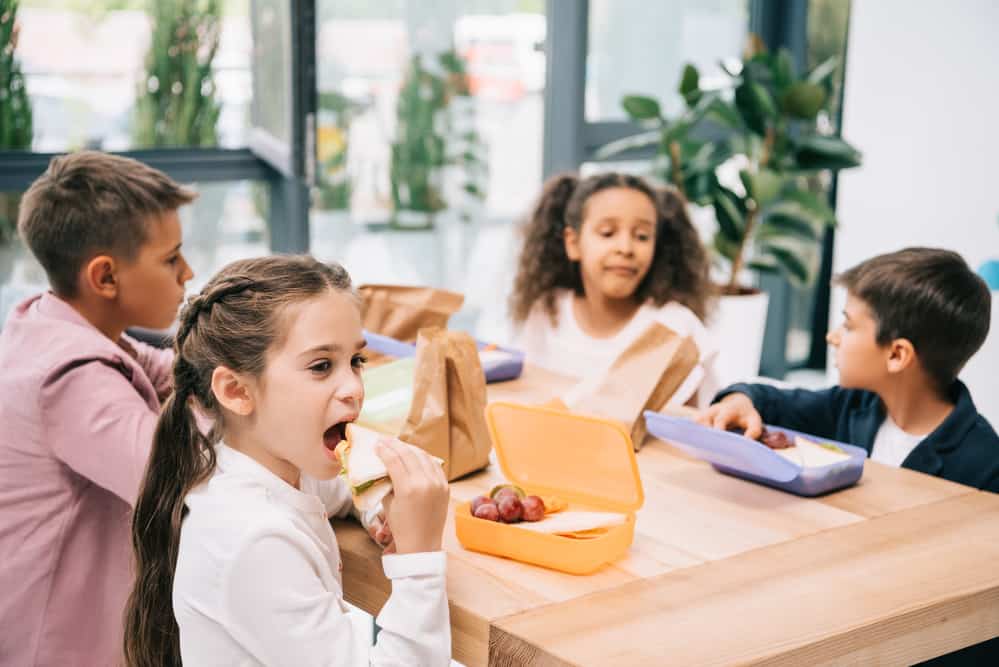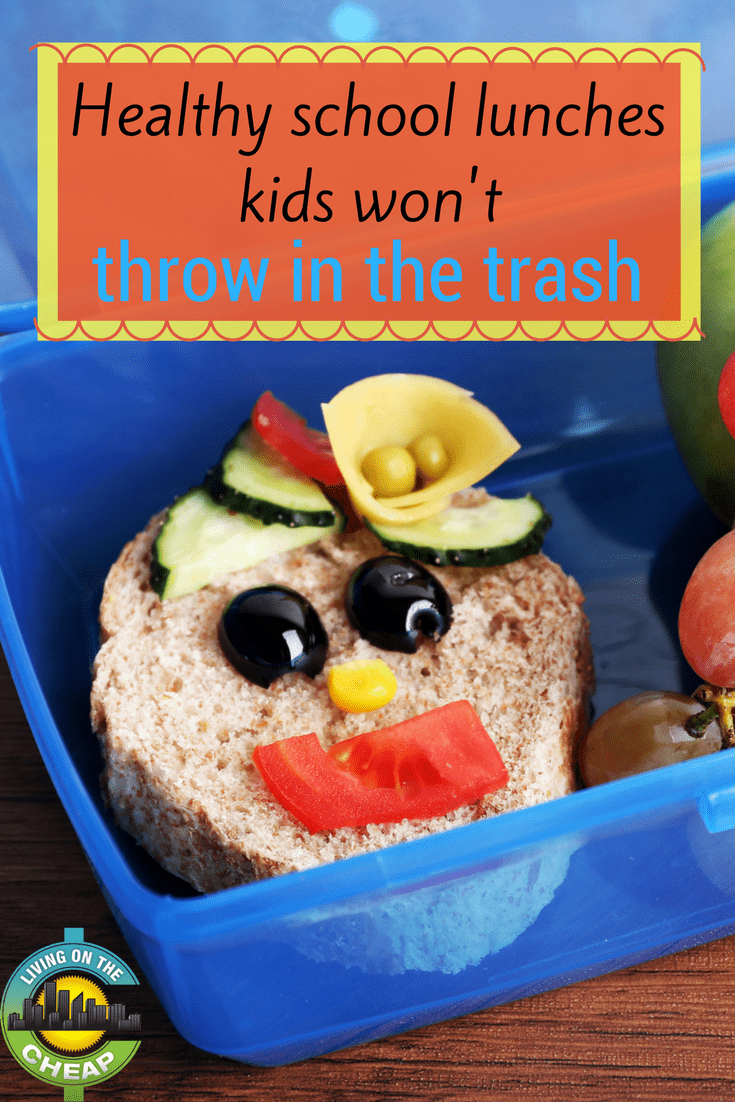If your child regularly brings their lunch to school, you’ve faced the “what to pack” dilemma. You want to pack something nutritious, but you also need to be sure your kids will eat it. A thrown-out lunch does nothing for your child’s health or your wallet; it’s basically cash in the trash.
Here are some simple tips to pack healthy school lunches for kids so that they fuel their minds and bellies.

In addition to providing roughly a third of the nutrients your child’s body needs to grow and be healthy, a well-balanced lunch also provides brain and body energy to remain alert and focused for the rest of the school day. So, making sure your child eats it is crucial. Finding that balance of nutritious and delicious can sometimes be a challenge, but it’s far from impossible.
 I spoke to my friend Sally Kuzemchak, a registered dietitian, author of Cooking Light Dinnertime Survival Guide: Feed Your Family. Save Your Sanity and author of the Real Mom Nutrition blog, to get her ideas. Most of us view a school lunch as a sandwich, a side, a drink and maybe a treat, but Kuzemchak thinks in broader categories: “A protein source, whole grain, fruit, vegetable, and ideally a calcium source as well,” she says. This concept can broaden your possibilities and allow you think “outside of the lunchbox.”
I spoke to my friend Sally Kuzemchak, a registered dietitian, author of Cooking Light Dinnertime Survival Guide: Feed Your Family. Save Your Sanity and author of the Real Mom Nutrition blog, to get her ideas. Most of us view a school lunch as a sandwich, a side, a drink and maybe a treat, but Kuzemchak thinks in broader categories: “A protein source, whole grain, fruit, vegetable, and ideally a calcium source as well,” she says. This concept can broaden your possibilities and allow you think “outside of the lunchbox.”
For example, a lunch of whole-grain crackers, turkey and cheddar cubes, melon balls, and cucumber sticks with some dip meets all the requirements, as does a slice or two (depending on size) of leftover pizza and apple slices with peanut butter. Even a basic sandwich can be more appealing if you swap out plain bread for cinnamon bread, a hot-dog roll, a whole-grain mini bagel, or a whole-grain tortilla.
Here are some foods that would fit into each group that you could mix and match to create lunches with kid-appeal:
Healthy Food Lunch Options
Protein: Deli meat slices (that could be rolled up) or cubes, nut butter, hard-boiled egg, edamame, hummus.
Whole grain: Crackers, tortilla, different breads, different types/shapes of rolls, popcorn.
Fruit: Apple slices, orange smiles, melon balls, raisins, pineapple chunks, no-sugar added applesauce or fruit cups.
Veggies: Cucumber sticks, colorful pepper rings, pizza or tomato sauce, carrot sticks or canned green beans (rinsed and drained). A bit of low-fat dip goes well with many of these.
Calcium source: Low-fat milk, reduced-fat yogurt, cheese cubes or slices, cottage cheese (some kids might like their fruit mixed in with this)
School Lunch Recipes for Kids
Pack yogurt, cut-up grapes or diced apples/pears, a whole grain cereal in separate containers and your child can make a yogurt parfait by combining it all at school.
Homemade soups are great for cold days. Make a vegetable-packed minestrone or one of these recipes on the weekend for the upcoming week or have it for dinner and send the kids with leftovers for lunch.
Kuzemchak also has two yummy, homemade fruit leather recipes on her blog that could be made on the weekends for simple grab-and-go during the week: strawberry fruit leather and apple cinnamon fruit leather.
These Mini Deep Dish Pizzas are incredibly easy. They can be eaten cold or you can reheat them and throw them into a thermos if your kids prefer them warm. Use your kids favorite toppings to personalize them.
Homemade granola is also easy to make and can be frozen to stay fresh longer.
Once or twice a week, surprise your child with a sweet ending to his or her lunch. This can be as simple as a handful of chocolate kisses or a pudding cup. If you’re a baker, bake up a batch of cookies one weekend that you can freeze and dole out over the course of several weeks.
Tips to Prep School Lunches
Try it out at home. Make some test lunches and offer them to the kids on weekends. They can offer feedback and tell you which ones are favorites — and which ones might get thrown in the trash.
Keep it fairly simple. Remember that lunch time in some schools can be as short as 10 to 15 minutes, and if children have to spend most of their time opening difficult containers or spreading sauces, etc. they may not have enough time to eat. Ready to eat, dump and mix, or finger foods and dips are all good choices.
Kuzemchak warns, “Be careful about packing too much. I find that if I scale back on the portions and number of items I pack, my kids eat more. Large lunches are overwhelming for small kids, especially when they have a limited time to eat.”
Be sure to keep cold foods cold (with an ice pack) and hot foods hot (in a thermos). When I have both hot and cold foods for my kids, the cold food goes in the lunch box with the ice pack and the thermos goes in a separate bag that I tie onto the lunch box handle.
I also like my kids to drink milk for lunch, so I make a tray of mini milk ice cubes and each morning I pop one in their milk cup. It’s just a little extra insurance that the milk stays cold, in addition to the ice pack.

How to prep school lunch
Another challenge with creating a healthy and yummy lunch is carving out time to make one. Kuzemchak has some helpful tips:
Do as much as you can the night before. Mornings are crazy enough.
Involve your kids if possible. For instance, make a little chart on selections you both agree on and have items kids can grab and pack
Prep some items on the weekends. For example, freeze sandwiches for the week then pop them in the lunchbox the night before when you’re packing. By lunch, they’ll be defrosted. Wash and cut vegetables.
Get gear that makes it easy. I’m a huge fan of the Easy Lunchboxes and Ziplock dividing lunchbox containers because you can fit everything in the compartments but there’s only one container and one lid. Reusable containers are not only good for the planet, but think of the money you’ll save on baggies and foil. Plus no more flat sandwiches from apples smooshing them.
- BPA-Free Food Grade All-in-One Bento Lunch Box -- The safety of this product is passed the professional laboratory testing, test reports are available for viewing if you want. DaCool bento lunch boxes are made of superior quality food-grade materials, NO PVC, Vinyl, Lead, and non-toxic, please enjoy this adults bento box without any worries
- Larger 3 Stackable Bento Box -- 74 OZ / 2190 ML large capacity, 3 layers stackable design adults lunch box, built in 2 sauce containes, fork and reusable spoon for easy dining. Not noly is it great for packing main course, sandwich, meat, salad, vegetables and more nutrient food, but also for packing nuts, fruits, yogurt, cake, candy, sauce and more, help you plan a well-balanced lunch
- Leak-Proof for Both Layer Bento Lunch Box for to Go -- Better than other bento boxes only one layer leak proof, our all-in-one bento box is adopting a double layer fully sealed design, can help you assemble different foods more freely, can keep food fresh that will not leak out or mess with other compartments food and mess-free during transport, convenient to carry around
- Tips: The cover image of the packaging box is a teal bento box, but inside is the the correct color bento box you choose. If you have any questions or suggestions after you receive the bento lunch box, please feel free to contact us
- 8-in-one: You will get 1 Brown Bento Box, 1 Spoon, 1 Fork, 1 plastic Sauce Jar and 4 silicone Muffin Liners. This bento box set can meet your needs for daily dining accessories
- With 4 Compartments: Bento box adult lunch box has 1200ml / 40oz capacity, with 4 compartments for different kinds of food. Separate compartments to maintain the original flavor of the food. Perfect capacity size is suitable for all ages
- 【3 Compartment Design】 Three perfectly portioned compartments for the bento box allows you to store different food separately, there's enough room for you to separate fruits and veggies, healthy snacks and dipping sauces according to your balanced diet.
- 【Safe and Reusable】 The straw bento box is made of high-quality polypropylene and wheat fiber materials, which is safe and healthy
- 【Lightweight and Portable】 Wheat straw bento box is lightweight which can be carried easily in a backpack or lunch bag when you go out or preparing for a picnic. It keeps the food fresh and you can eat healthy and delicious food even in the wild!
These ideas should help you get the school year (at least school lunch) off to a great start.
What should I not pack in a lunchbox?
You know your child an what they need best. Make good food choices that will help your child throughout the school day so that they can be in-seat and concentrate on learning.
That doesn’t mean you shouldn’t pack them fun foods, but giving them a lunch box full of sugary sweets might be a recipe for making them full of energy and having difficulty concentrating.
Do your best to include foods that are healthy and delicious, and communicate with them what they’re hoping to find in their school lunch.
When you’re all on the same page, it’s the best approach for them to be able to enjoy their lunch and not waste any of the food.
If you liked this article, you may also enjoy:
Kids stuck at home for snow days? Play board games
Keep the kids cool with DIY ice pops





All really good suggestions. Just keep in mind most schools no longer allow peanut butter, or in some instances all nut butters are disallowed. This is due to an increasingly large number of nut allergies that have developed in the last few decades.
Thank you Julie for that reminder. While some schools don’t allow peanut butter, many allow nut butters and many allow both. In some schools they have but free tables or zones. However, fortunately the several other protein options mentioned in this article are great nutrient-dense, yummy options.